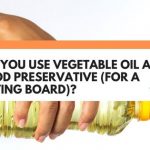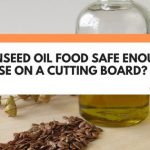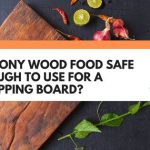Acrylic paint is a great top coat for wooden surfaces.
This colorful finish dries in a fraction of the time of oil-based paint. And, once dry, Acrylic paint still has a bit of elasticity to it. So, it doesn’t flake and crack.
All of this adds up to Acrylic paint being the perfect fit for wooden surfaces. Especially since wood likes to ‘breathe’ and shift around with any change in temperature/humidity.
But, once dry, how does this water-based paint measure up as a food-safe surface?
In this post, we dive into what goes into your typical pot of Acrylic paint. You will also learn what makes a food safe paint different from an acrylic one.
And keep reading to find out if this paint is really the best top coat option for your cutting board…
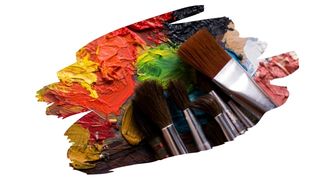
This post may contain affiliate links to products that we receive a commission for (at no additional cost to you). Learn more here.
What Is Acrylic Paint Made From?
Acrylic Paint is made by blending plastic acrylic particles, chemical pigments, and water.
Now, the water is the key to acrylics fast-drying, (especially when compared to oil paint). That is because as the water evaporates, those acrylic particles begin to bind to one another.
And between the plastic acrylic and pigments left behind, you end up with a colorful and flexible coat.
Related Post: Is Lacquer A Food Safe Wood Finish?
Can You Make Acrylic Paint Food Safe?
No, not possible. And the problem lies in the plastic particles found in this particular paint.
This paint needs that plastic in order to form its flexible coat. You remove the plastic, you essentially have no acrylic paint substances.
This makes Acrylic paint a toxic substance completely unfit for human consumption.
Is Acrylic Paint Really That Toxic To Ingest? Acrylic paint, if applied topically, can irritate your skin. And, if ingested in large amounts, it can cause vomiting.
Is Acrylic Paint At Least Safe Around Food? Can It Form A Food Safe Surface?
A dry coat of Acrylic paint is not a food safe surface. There’s a risk of micro plastic particles getting into any food that comes in contact with it.
So What Kind Of Paint Is Safe Around Food?
The only type of paint, (that you can risk coming into contact with your food), are certified food safe paint products.
These food safe paints are used to paint areas such as restaurant kitchens, food manufacturing plants, and even water tanks. And, a food safe paint is one that only contains US FDA certified food safe resins and coatings.
Anything outside of that…well, simply isn’t food safe.
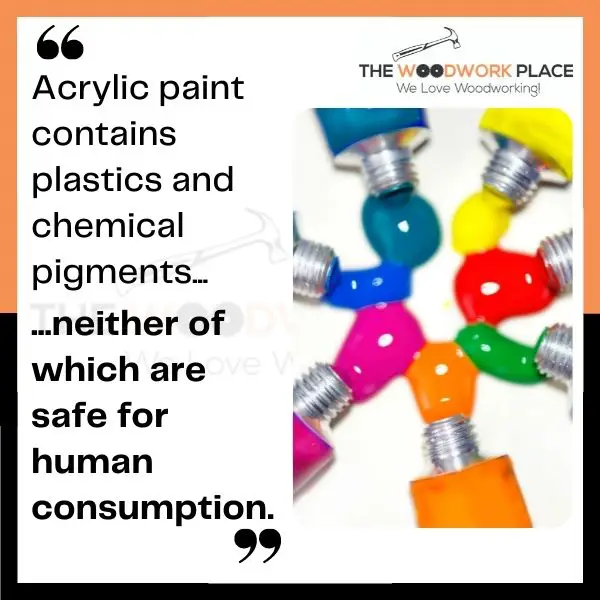
And This Food Safe Paint Is Safe For Cutting Boards Too?
A food safe paint can be applied to a cutting board. However, paint in general is not a suitable top coat for any cutting board.
The only time you would use paint on a cutting board, is if that board is just for decoration.
Otherwise, a cutting board designed for food prep, is going to be put through a lot of work. It will undergo a lot of washing, a lot of chopping and plenty of slicing too.
That’s why an actively used cutting board needs to be left somewhat ‘unfinished’. Any kind of final sealing finishing top coat (such as paint) won’t be durable enough to last atop a chopping block. And that’s because your kitchen utensils will slice through a paint coat like a knife through butter.
So instead, we typically protect the wood of a chopping block by saturating it with a non-drying oil. Non-drying oils don’t form a solid seal on the surface, and they don’t dry into a solid resin or coat.
This is important, because mineral oil is key to maintaining a regularly used cutting board. This non-toxic oil seals your cutting board by soaking right down into wood grain. There, it coats wood fibers with a water-repellent oil that prevents your cutting board from absorbing water. This, in turn, will keep your cutting board from decaying and rotting away.
But, if you were to coat a cutting board with paint, you will stop mineral oil from being able to sink into the board.
Related Post: Walrus Oil Vs Mineral Oil: Which One’s Better For Your Cutting Board?
To Sum Up, Here Are The 3 Key Takeaways From This Post…
- 1). Acrylic paint contains plastics, and chemical pigments, neither of which are safe for human consumption.
- 2). The only kind of paint that is food safe, is one that only contains US FDA food safe ingredients.
- 3). Regardless, paint is not a suitable top coat for a cutting board. That paint coat can be easily damaged by your heavy-duty kitchen utensils.
References:
Acrylic Paint | Missouri Poison Center

